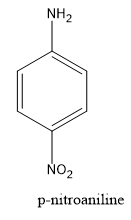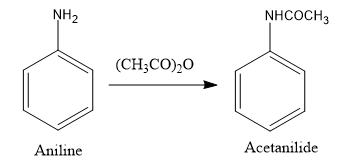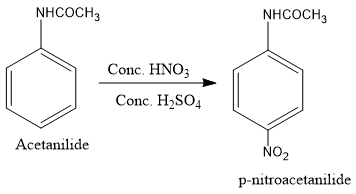
Convert Aniline into p-nitroaniline.
Answer
480.6k+ views
Hint: Aniline is an organic compound which consists of an amine functional group attached to the benzene ring while p-nitroaniline is also an organic compound in which the nitro functional group is attached at fourth position in Aniline. So, to convert Aniline into p-nitroaniline we would need to introduce a nitro group to the aniline. We will see the step by step conversion from aniline to p-nitroaniline in the solution.
Complete answer:
First we will see the structures of both aniline and p-nitroaniline.


We know that aniline is an organic compound which consists of an amine functional group attached to the benzene ring while p-nitroaniline is also an organic compound in which the nitro functional group is attached at fourth position in Aniline.
Now, to introduce nitro group in the aniline ring, the reagents used are $conc.HN{O_3}$ and $conc.{H_2}S{O_4}$ which are very strong acids. Amino group of aniline is a very strong base so it has great affinity towards these acids. Therefore, we need to protect amino group first by reacting aniline with acetic anhydride as follows:

Then, the acetanilide formed is reacted with $conc.HN{O_3}$ and $conc.{H_2}S{O_4}$ to introduce nitro group at the para position. Nitro group is introduced at para position because the para position is the most active site as it has the highest electron density.

p-nitroacetanilide is hydrolysed to form p-nitroaniline.

Hence, in this way p-nitroaniline is synthesised from aniline.
Note:
We should remember that aniline is a very strong base and the amine group has great affinity towards the acid and if we do not protect the amine group it will react with the acids. Hence, the nitro group will not be introduced in the aniline ring. After introducing the nitro group in aniline ring, the amine group is deprotected by hydrolysis.
Complete answer:
First we will see the structures of both aniline and p-nitroaniline.


We know that aniline is an organic compound which consists of an amine functional group attached to the benzene ring while p-nitroaniline is also an organic compound in which the nitro functional group is attached at fourth position in Aniline.
Now, to introduce nitro group in the aniline ring, the reagents used are $conc.HN{O_3}$ and $conc.{H_2}S{O_4}$ which are very strong acids. Amino group of aniline is a very strong base so it has great affinity towards these acids. Therefore, we need to protect amino group first by reacting aniline with acetic anhydride as follows:

Then, the acetanilide formed is reacted with $conc.HN{O_3}$ and $conc.{H_2}S{O_4}$ to introduce nitro group at the para position. Nitro group is introduced at para position because the para position is the most active site as it has the highest electron density.

p-nitroacetanilide is hydrolysed to form p-nitroaniline.

Hence, in this way p-nitroaniline is synthesised from aniline.
Note:
We should remember that aniline is a very strong base and the amine group has great affinity towards the acid and if we do not protect the amine group it will react with the acids. Hence, the nitro group will not be introduced in the aniline ring. After introducing the nitro group in aniline ring, the amine group is deprotected by hydrolysis.
Recently Updated Pages
Master Class 12 Business Studies: Engaging Questions & Answers for Success

Master Class 12 Economics: Engaging Questions & Answers for Success

Master Class 12 English: Engaging Questions & Answers for Success

Master Class 12 Maths: Engaging Questions & Answers for Success

Master Class 12 Social Science: Engaging Questions & Answers for Success

Master Class 12 Chemistry: Engaging Questions & Answers for Success

Trending doubts
What is meant by exothermic and endothermic reactions class 11 chemistry CBSE

Which animal has three hearts class 11 biology CBSE

10 examples of friction in our daily life

One Metric ton is equal to kg A 10000 B 1000 C 100 class 11 physics CBSE

1 Quintal is equal to a 110 kg b 10 kg c 100kg d 1000 class 11 physics CBSE

Difference Between Prokaryotic Cells and Eukaryotic Cells




